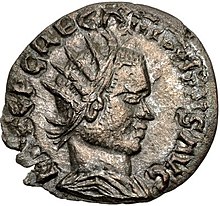
Back ريجاليانوس ARZ رقالیانوس AZB Регалиан Bulgarian Regalianus Breton Regalià Catalan Regalianus Czech Regalianus German Ρεγαλιανός Greek Regaliano Spanish رگالیانوس Persian
| Regalianus | |
|---|---|
| Usurper of the Roman Empire | |
 | |
| Reign | c. 260, 260–261 or 261 |
| Predecessor | Gallienus |
| Successor | Gallienus |
| Died | 260/261 (aged c. 45/46) Carnuntum, Pannonia Superior |
| Spouse | Sulpicia Dryantilla |
P. C. Regalianus (died 260/261), also known as Regalian, was Roman usurper for a few months in 260 and/or 261, during the Crisis of the Third Century, a period of intense political instability in the Roman Empire. Regalianus was acclaimed emperor by the troops along the Danube river, a region of the empire that frequently experienced barbarian raids, probably in the hope that he might be able to secure the frontier.
Accounts by surviving literary sources concerning Regalianus are brief and few in number, and are mostly considered unreliable. The Historia Augusta relates that he was of Dacian descent, and a descendant of the Dacian king Decebalus, but this is mostly rejected in modern scholarship. Regalianus was married to Sulpicia Dryantilla, a woman from a prestigious senatorial family, which instead points to Regalianus also being of high-ranking Roman descent. Regalianus' acclamation as emperor was in the wake of a previous usurpation attempt by Ingenuus, also proclaimed by the Danube troops, that had been defeated by emperor Gallienus (r. 253–268). Unlike Ingenuus, and revolutionary for an imperial claimant, Regalianus founded his own mint at Carnuntum, his seat of power. He minted coins of himself and his wife, though they were typically of poor quality.
Regalianus' local usurpation of power was beneficial for Gallienus, as it allowed the emperor to focus his attention on defending Italy from an invasion by the Alemanni while Regalianus was occupied fighting the barbarians in Illyria. After a brief "rule" of several months at Carnuntum, Regalianus was killed. How exactly he met his end is not entirely clear, but the most commonly accepted theory is that he died during a raid of Carnuntum by the Roxolani, possibly aided by a contingent of his men who had grown to oppose him.